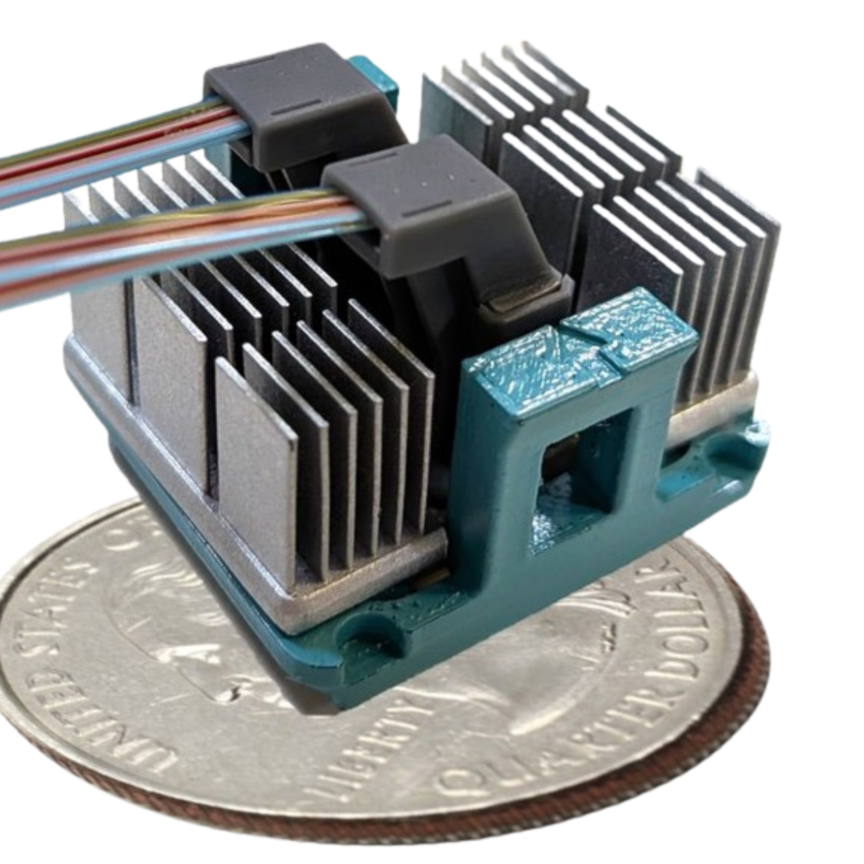European scientists are using lasers to create light-speed broadband connections and remove the data bottlenecks that could cause the internet to grind to a halt as demand increases.
A group of EU-funded researchers are incorporating VCSEL laser sources with silicon photonics to develop long wavelength, high capacity communications. The aim of the project - called 'PASSION' - is to reduce the current power consumption of the internet by ten times their current rates. VCSEL light sources are key for achieveing this because of their high transmission efficiency and minimal power consumption.
This will significantly improve metropolitan connectivity, and power new ‘smart’ services like future gaming and on-demand TV.
Vertical cavity surface emitting lasers (VCSEL), which are already employed in consumer products such as Apple's iPhone X to scan a user’s face for Face ID, are cheap to manufacture, and are more efficient than traditional laser sources.
Future smart services require a massive overhaul of current internet infrastructure. Data ‘bottlenecks’ - or internet ‘traffic jams’ caused by the huge volume of users with devices running, music, video, gaming, AI, VR and telecommunications – urgently need to be freed up. VCSELs have the potential to improve smart services that consume enormous amounts of data. With transmission rates up to 112 Tb/s, sending 28 thousand HD movies would take just one second.
While VCSELs have been used in data communications for short-distance connections in intra-data centres, using these infrared lasers for long wavelength, and high capacity communications has never been done before to connect cities.
Scientists harness photonics to develop faster, high capacity, internet from Matter PR on Vimeo
Project coordinator Professor Pierpaolo Boffi said: 'VCSELs are a bit of a buzz word at the moment. They have the advantages of low driving current, high light-power conversion efficiency and high directivity. This makes them an ideal choice for transmitting huge amounts of data in a low cost, energy efficient way,' he commented. 'VCSELs will help us target the site of the "bottlenecks" - the metropolitan area networks [MANs] interlinking users within a geographical area where all the internet traffic from a local area flows, and cope with the exponential growth in users and increasingly sophisticated services like gaming, assisted living and on-demand TV.
'Our researchers are developing a flexible network architecture that will be optimised for metropolitan applications based on aggregated signal flows. A tenfold reduction in power consumption will be achieved by exploiting the full wavelength spectrum and the space dimension in a multi-core fibre.'
The need for faster networks
US internet technology giant Cisco predicts that internet traffic will grow to an unprecedented 3.3 trillion gigabytes (3.3 zettabytes) per year between 2016 and 2021.
In as little as three years from now, internet usage will reach three trillion internet video minutes per month, according to the Cisco report. To put this usage into perspective, this is five million years of video per month, or one million video minutes every second.
With the exponential growth rate of users, and the enormous amount of data being sent and received through complex devices, such as gaming, TV and telecoms, the internet as we know it, so project coordinator Professor Pierpaolo Boffi believes, will grind to a halt if nothing is done.
'If we are serious about having super-connected citizens, using broadband services such as telework, improved entertainment such as HD and 3D TV on demand, or gaming, remote healthcare, assisted living, enhanced social networking, ‘eLearning’ for example, we need a fibre optic network that is leagues ahead of where it is now. We need a lighter and more flexible internet with low energy consumption. Otherwise, the future internet costs will be unsustainable.'
PASSION will come up with new transmission, detection, and routing solutions as well as an advanced network architecture based on innovative laser sources, Boffi added. 'These solutions ensure a transmission rate of more than 100 Tb/s per link and a switching capacity of over 1 Pb/s per node.'
VCSEL Silicon Photonics
Developing a new technological platform for their network components, the PASSION group will incorporate VCSELs to silicon photonics for the further reduction of the packaging costs of such a technology platform.
'VCSELs could be the next big leap in metro communications,' explained PASSION project manager Paola Parolari. 'They are already employed widely in data communications, in intra-data centre short-distance connections for example. However exploiting VCSELs, emitting at long wavelengths and integrated in silicon photonics to realise multi-channel modules with very high communication capacity can have tremendous impacts on the fibre networks of our cities in terms of cost, footprint and energy saving.'
Coordinated by the Politecnico di Milano the PASSION consortium secured a grant of €7,535,747 from the European Commission under the H2020 funding program and was funded under the Photonics Public Private Partnership (PPP).
PASSION is comprised of 14 partners with participants from 7 different European countries: (Italy) Politecnico di Milano and SM Optics; (Spain) CTTC, Telefonica and VLC Photonics; (The Netherlands) Technische Universiteit Eindhoven and Effect Photonics; (Finland) VTT; (Germany) Vertilas; (Israel) OpSys Technologies; (France) EPIC; and from 2 extra-Europe countries: (Japan) NICT and (South Korea) ETRI and ChemOptics.

